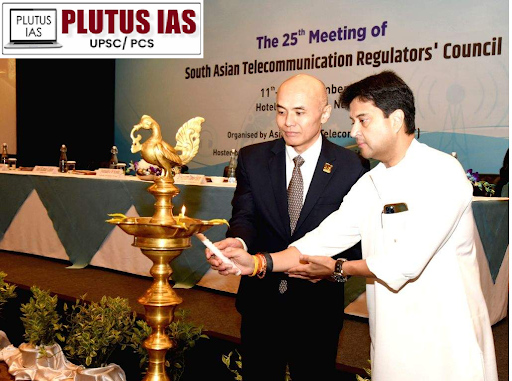12 Nov Prelims Bits: South Asian Telecommunication Regulators’ Council (SATRC) And NTN Technology
South Asian Telecommunication Regulators’ Council (SATRC)
This article covers “prelims-related topics The South Asian Telecommunication Regulators’ Council (SATRC) and NTN technology.
SYLLABUS MAPPING:
GS: Current events of national and international importance.
FOR PRELIMS:
What is SATRC and its members? What is NTN technology, its applications, and its advantages?
Why in the News:
Minister Jyotiraditya M. Scindia recently inaugurated the 25th South Asian Telecommunication Regulators’ Council (SATRC) meeting, emphasizing the need for collaborative efforts to build a transparent, secure, and standards-driven future in telecommunications. This meeting focused on strengthening regional cooperation among South Asian nations to address emerging challenges and foster sustainable digital growth.

What is SATRC?
The South Asian Telecommunication Regulators’ Council (SATRC) is a collaborative platform that operates under the Asia-Pacific Telecommunity (APT) to address regulatory and policy issues related to telecommunications and information and communication technology (ICT) in South Asia. Established in 1997, SATRC aims to facilitate cooperation among telecommunication regulators in the region.
Origin
SATRC was formed as a result of an initiative by the Asia-Pacific Telecommunity (APT) and the International Telecommunication Union (ITU) Regional Office for Asia and the Pacific. Its establishment was driven by the need for a coordinated approach to address common regulatory challenges faced by South Asian countries in the rapidly evolving telecommunications landscape.
Members
The council comprises the heads of regulatory bodies from nine South Asian countries:
Afghanistan
Bangladesh
Bhutan
India
Iran
Maldives
Nepal
Pakistan
Sri Lanka
Major Areas of Functions
Regulatory Coordination: Discussing and coordinating common regulatory issues among member countries.
Radio Frequency Coordination: Addressing issues related to the allocation and management of radio frequencies.
Standards Development: Promoting the establishment of standards in telecommunications to ensure compatibility and interoperability.
Regulatory Trends and Issues: Analyzing current regulatory trends and addressing emerging challenges in the telecommunications sector.
Telecommunication Development Strategies: Formulating strategies to enhance telecommunication infrastructure and services across the region.
International Affairs: Engaging in discussions related to international telecommunications policies and agreements.
Capacity Building: Facilitating seminars, training, and workshops to enhance the skills and knowledge of regulatory personnel.
Non-Terrestrial Networks (NTNs)
What is NTN?
Non-Terrestrial Networks (NTNs) are advanced wireless communication systems that operate above the Earth’s surface. They utilize various platforms, including satellites in low Earth orbit (LEO), high-altitude platform stations (HAPS), and uncrewed aircraft systems (UAS). NTNs are designed to provide seamless connectivity, especially in remote and underserved areas where traditional terrestrial networks may not reach.
Key Features of NTNs
Global Coverage: NTNs extend wireless communication capabilities globally, ensuring connectivity over land, sea, and air, which is crucial for IoT applications and emergency services.
Integration with Terrestrial Networks: NTNs are not meant to replace terrestrial networks but to augment them, providing a hybrid solution that combines the strengths of both satellite and terrestrial communications.
Diverse Applications:
IoT Connectivity: Enabling global IoT deployments for asset tracking, environmental monitoring, and smart agriculture.
Emergency Services: Providing critical communication capabilities during disasters when terrestrial networks may be compromised.
Maritime and Aviation: Enhancing connectivity for vessels and aircraft, improving navigation and operational efficiency.
Evolution of NTNs
NTN-IoT and NTN-NR: The NTN framework includes two main aspects:
NTN-IoT: Focused on expanding IoT coverage, primarily operating at geostationary (GEO) and low Earth orbit (LEO) altitudes.
NTN-NR: Aimed at linking smartphones and 5G devices directly to satellite networks, facilitating low-data services, voice, and messaging.
Technological Advancements: The development of NTNs is supported by advancements in satellite technology, artificial intelligence, and software solutions that enhance connectivity and network management.
Benefits of NTNs
Seamless Connectivity: NTNs provide uninterrupted access to communication services, regardless of geographical barriers, benefiting individuals and businesses alike.
Support for Emerging Technologies: NTNs are expected to play a significant role in the future of 6G, enabling new services and capabilities such as high-precision location services and integrated sensing.
Economic Growth: By improving connectivity in remote areas, NTNs can drive economic development, enhance public safety, and support critical infrastructure projects.
Future Outlook
Growth Potential: The market for NTNs is anticipated to grow significantly, driven by increasing demand for global connectivity and advancements in satellite technology.
Strategic Importance: As nations invest in NTNs, they will play a crucial role in shaping the future of telecommunications, particularly in the context of national security and global competitiveness.
Conclusion:
Non-terrestrial networks represent a transformative approach to telecommunications, offering innovative solutions to connectivity challenges and paving the way for a more interconnected world.
Download plutus ias current affairs ENG 12th Nov 2024 pdf
Prelims Questions:
Q.1. Which of the following are applications of Non-Terrestrial Network (NTN) technology?
1. Global IoT connectivity
2. Emergency communication services
3. Terrestrial broadband internet
4. Maritime and aviation communication
Select the correct answer from the options below:
A. Only one
B. Only two
C. Only three
D. All four
ANSWER: C
Q.2.Consider the following countries:
1. Afghanistan
2. Iran
3. Myanmar
4. Maldives
5. Bhutan
How many of these countries are members of the council comprising the heads of regulatory bodies under SATAC?
Only two
Only three
Only four
All four
ANSWER: C




No Comments